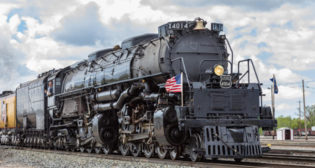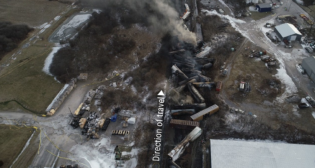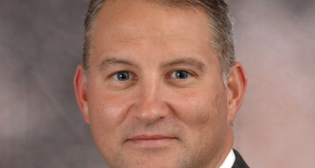
Balancing Public, Private Interests Before the STB
Written by David Peter Alan, Contributing Editor
More than 300 people rode Amtrak’s Gulf Coast Inspection Train (pictured) from New Orleans to Jacksonville, Fla., in February 2016, as part of an ongoing effort to restore passenger rail service along the Gulf Coast, which was disrupted by Hurricane Katrina in 2005 and never resumed. (Marc Glucksman, Amtrak)
For several months, Railway Age has reported extensively on Amtrak’s efforts to begin running two daily round trips between New Orleans and Mobile, and the strong opposition to the plan voiced by CSX and Norfolk Southern (NS). The focus has been on the railroads. But there's another vital interest at stake: that of the American people to be able to ride new services on “America’s Railroad.”
Earlier this month, I reviewed the pleadings filed in the matter currently before the STB. Shortly thereafter, I commented on the Mobile matter as a test of Amtrak’s ability to implement its planned map for 2035, a plan that calls for establishing a large number of state-supported trains and corridors.
Since that time, comments to the STB have concentrated almost exclusively on one issue: the value of the capacity (primarily CSX’s) that would be “taken” to start the new passenger route. It appears that the commenters have concentrated so strongly on CSX’s and NS’s interests that they have neglected those of the riding public.
One commenter mentioned a Constitutional issue: the Fifth Amendment prohibition against government “taking” private property. The actual language prohibits taking private property for public use “without just compensation.” So how much of CSX’s and NS’s capacity would Amtrak need to run two daily round trips between New Orleans and Mobile? Also, how much is it worth?
The Surface Transportation Board (STB) has the statutory authority to decide such valuations—essentially the power to arbitrate, with appropriate assistance from the Federal Railroad Administration (FRA). That grant of authority makes sense, because the people at those two agencies are more familiar with railroad infrastructure and economics than their counterparts elsewhere in government. Railroads were the first industry to be regulated in the “public interest, convenience and necessity,” starting with the founding of the STB’s predecessor agency, the Interstate Commerce Commission (ICC) in 1887.

In Railway Age’s “Is Amtrak Coming Home to Alabama?” article, Contributing Editor Jim Blaze laid out many issues before the STB in the present case, and possibly in many similar cases in the future. While his analysis makes sense, there are vital issues that deserve to be explored further: mobility through the use of infrastructure assets that were originally designed to provide for transportation of both passengers and freight, the public benefit that would be achieved by expanding mobility for people in the region, and the power to decide how much such additional mobility is worth.

How far STB Chair Martin Oberman and his colleagues will move toward the old public-interest standard of the ICC as time goes by is yet to be determined, but there is more-recent precedent for a government agency to arbitrate rates for use of private property under license. The Copyright Act of 1976 established the Copyright Royalty Tribunal to determine how much users of copyrighted works (often music, art or literature) must pay to the copyright holders to use those works. The statute established compulsory licenses for certain entities like non-commercial broadcasters and others who play recorded music (mechanical rights).
Similarly, the statutory provision that gives the STB jurisdiction over the level of compensation a host freight railroad should receive for allowing Amtrak trains on its track establishes a different sort of compulsory license and assigns an agency with specialized knowledge to determine how much compensation is “just.”
The “right to travel,” which many Americans believe to be fundamental, is not enshrined in the Constitution as precisely as other provisions, but it appears reasonable to claim that there is a legitimate public interest in providing an additional amount of mobility for non-motorists as well as motorists, especially since government action has spent roughly $1 trillion to build the Interstate Highway system, which is available to motorists and not to the large minority of Americans who are not, unless they’re riding a bus.
Currently available non-automobile transportation between New Orleans and Mobile consists of two daily roundtrip bus runs operated by Greyhound. One runs non-stop; the other stops at Biloxi. Nothing serves: Bay St. Louis, Gulfport or Pascagoula (although there is limited local bus service between Biloxi and Gulfport). The proposed train service would increase mobility for persons living in those communities or who wish to visit them. Provided the compensation to the host railroads is fair, Amtrak’s proposed Gulf Coast service would appear to constitute a legitimate public purpose.

The amount CSX and NS seek as compensation to build additional infrastructure to accommodate two Amtrak round trips is almost 20 times the amount determined by the FRA. It is difficult to fathom what sort of infrastructure improvements CSX and NS would require as a pre-condition to allowing Amtrak, and by extension, the riding public, access to the Gulf Coast. How much additional infrastructure would they actually require, in terms of passing sidings, track improvements to handle 79-mph passenger train speeds, and PTC? Such improvements, along with some careful scheduling—which I would think is feasible under PSR, Precision “Scheduled” Railroading—should do the job. The STB should be able to determine that, especially with help from the FRA as needed.
Amtrak President Stephen Gardner told Railway Age, several times, that PSR should actually be beneficial to Amtrak. “I take some level of excitement with Precision Scheduled Railroading, which means running freight trains as we run passenger trains—concrete schedules and a high level of reliability. As they move toward that, it could be great for us,” he told Railway Age Capitol Hill Contributing Editor Frank N. Wilner in March 2019.

Except within the narrow context of who actually owns the right-of-way, Jim Blaze’s use of the term “freight rail assets” may not be entirely accurate, because passenger trains can utilize the tracks. That a passenger train has not run for a long time on a particular right-of-way does not change the potential of the asset for people as well as freight.
Jim considers Amtrak to be a “niche market,” but that characterization downplays, at least to me, the types of improvement in the freight rail network that could broaden public interest in Amtrak and desire to ride its trains. In other words, Amtrak can be considered a “niche market” in some places (outside the areas served by busy corridors, like the Northeast Corridor) precisely because there are only a few trains—not enough to serve an aggregate market larger than that limited by the capacity of today’s skeletal Amtrak national network.

While railroads like CSX and NS may argue that Amtrak wants to run more trains than their tracks can currently accommodate without impacting freight service (current or with projected growth), the underlying problem for Amtrak is that it runs too few trains. Adding a few more trains in certain markets will help dispel any public perception that Amtrak serves a “niche market.” The more trains that run, the more Amtrak will be noticed. Ridership will grow.
There is a big problem that must be solved: The shortage of transparency and understandable numbers from both Amtrak and the freight railroads that would host new and/or expanded passenger services. I don’t know how much infrastructure CSX and NS would actually need to accommodate Amtrak’s proposed Gulf Coast schedule, other than CSX stands prepared to demand almost 20 times as much money for infrastructure as the FRA claims is needed to accommodate the new trains. Amtrak so far has not disclosed information that advocates for riders have requested, as they strive to understand Amtrak’s financial performance and offer suggestions to improve it.
The difficulty today involves private-sector property owners and a public-sector entity originally founded a half-century ago to provide service to the general public while relieving the private sector companies of their obligation as common carriers to provide that service. It’s the sort of situation where administrative agencies with specialized knowledge serve the public interest well by ensuring that private-sector interests do not overpower the public interest and deny access to the public.
The STB has been charged with performing a balancing act, which they are capable of performing, and which administrative agencies do well, as long as they maintain sufficient independence to avoid becoming captive to the industry they are charged with regulating.
As this story develops, there is ample reason for the STB, with appropriate help from the FRA, to fulfill its statutory responsibility and determine fair compensation for the host railroads. That is the sort of undertaking that administrative agencies do well, and the STB and FRA appear ready to do it.
Will the STB hold Amtrak, CSX and Norfolk Southern accountable so that the three can avoid costly litigation and negotiate, in good faith with full transparency, the true costs of implementing new services, and then ensure that services can begin within a reasonable time frame? The riders, their advocates and the nation’s taxpayers deserve nothing less. If the STB can make the process work, the American people might still get some new Amtrak services in the coming years. They may fall short of what Amtrak hopes to accomplish by 2035, but at least some progress will have been made.

David Peter Alan is one of America’s most experienced transit users and advocates, having ridden every rail transit line in the U.S., and most Canadian systems. He has also ridden the entire Amtrak network and most of the routes on VIA Rail. His advocacy on the national scene focuses on the Rail Users’ Network (RUN), where he has been a Board member since 2005. Locally in New Jersey, he served as Chair of the Lackawanna Coalition for 21 years, and remains a member. He is also a member of NJ Transit’s Senior Citizens and Disabled Residents Transportation Advisory Committee (SCDRTAC). When not writing or traveling, he practices law in the fields of Intellectual Property (Patents, Trademarks and Copyright) and business law. The opinions expressed here are his own.



